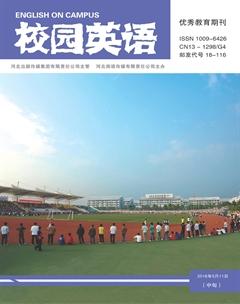Transliteration in EST Translation
【Abstract】Firstly, this paper presents the definition of transliteration and its important position in EST translation. Secondly, in terms of the previous practice and experience in EST translation, four main transliteration techniques are concluded and analyzed. But meanwhile, there are still some negative issues and phenomena. As a result, it is worthy to make good use of the existing transliteration techniques and create more proper ones to remove the obstructions and promote the development of EST translation.
【Key words】transliteration; transliteration technique; EST translation
Transliteration is a kind of translation method that represents in the corresponding characters of another alphabet. In a nutshell, transliteration is a process of sound recording from source language to target language, in order to find out the most approximate phonetic equivalents. There are some commonly-used techniques in transliteration in EST Translation.
● Pure Transliteration
This is the most typical and simple transliteration technique, which uses the letters or words pronounced as similarly as possible in Chinese to translate the original English words.
E.g. Marlboro, a product of the Philip Morris Company, is the most popular cigarette in the world,selling 130 billion cigarettes in 1993.
万宝路是菲利普·摩利斯公司的一种产品,它是全世界最流行的香烟,1993年它的销售量是1300亿支。
● Pure Transliteration with Adding
The characteristic of this technique is to maintain the pronunciation of the English words and then, on the basis of pure transliteration, add the Chinese characters that can point out the category or class the English words belong to.
E.g. ①WHO has rung alarm bells about a possible tuberculosis epidemic. Tuberculosis, which attacks mainly the lungs, intestines, skin and brain, causes larger death toll than that of pneumonia and AIDS.
世界卫生组织为结核流行敲起了警钟。结核病主要损害肺、肠、皮肤和脑,死于结核病的人比死于肺炎和艾滋病的人总和还要多。
②As a result, zinfandel is the perfect accompaniment to many foods and can be served on any occasion.
结果,津芬德尔葡萄酒成了多种食物的上好佐餐酒,在任何场合都能上得了台面。(加“葡萄酒”三个字)
In the first example, “艾滋”is translated through pure transliteration and “病”is the category word. Many years ago, AIDS was only translated into “艾滋”, it must have been very confusing for the target readers — what it is on earth, a sort of food or a dress. However, the category word “病”can express its meaning quite clearly . As for the second instance, “葡萄酒”is the category word.
● Partly Transliteration and Partly Semantic Translation
This is a synthetical method. Concretely speaking, it translates one part—it has the equivalence in Chinese—of the English word through semantic translation, and translates the rest through transliteration; both parts can compose a complete word. Here, semantic translation is the process of using semantic information to aid in the translation of data in one representation or data model to another representation or data model.
E.g. Originally a military research system,and then an academic system connecting university computers,the Internet is now an open global system of computer networks to which many Internet Service Providers have access.
因特网最初是一个军用研究系统,后又成为联接各大学计算机的学术系统,现在则己发展成为一个开放型全球计算机网络系统,拥有许多服务商。
Here, the initial part “inter” is translated into “因特” in terms of pure transliteration, whereas the final part “net” is rendered into “网” in that “net” and “网” are equivalent in the translation of English and Chinese, which adopts semantic translation.
● Both Transliteration and Semantic Translation
Although this technique seems like the third one, actually they are different in nature. This method is in the pursuit of the aim that makes the Chinese version both including the original pronunciation and its conceptual meaning, and the perfect impression of both image and expression.
E.g. TOEFL is a trademark for a standardized examination for proficiency in English as a foreign language.
托福是一种标准考试的标志,用于测试对作为外语的英语的熟悉程度。
Having the similar sound of “TOEFL”, “托福”in Chinese can depict the students blessing and desire for dream about studying in USA.
As is mentioned above, the transliteration techniques in EST translation are relatively abundant and systematic; however, some negative issues do exist in transliteration in EST translation, which has put or will exerted a heavy and negative impact on the introduction of new scientific discoveries and innovations, the knowledge of exotic scientific concepts and techniques, the understanding of new scientific theories.
Firstly, many technical terms havent unified transliterated versions. For instance, “laser” is translated into “激光”and“镭射”. This is very inconvenient for scientists exchanges and makes readers perplexed.Secondly, there are a lot of random transliterations in EST translation. Some irresponsible translators overemphasize on the form, sound and meaning of Chinese characters to mislead the target readers. E.g. “university” is rendered into“由你玩四年”. Perhaps it is ok in literature translation, but in EST translation, it is just a stunt and flubdub.
In conclusion, transliteration is an important and necessary method in interlinguistical exchange, especially in EST translation.Meanwhile, according to the previous EST translation practice and experience, a series of transliteration techniques have been concluded, which will be conducive to the development of EST translation.
References:
[1]The American Heritage Dictionary of the English Language(4th Edition),Houghton Mifflin,Bostonthe.
[2]Catford,J.C.,A Linguistic Theory of Translation.London.1965.
[3]周光文,高岩杰.试论科技术语的翻译[J].科技翻译论著集萃[M].北京:中国科学技术出版社,1994.
[4]萧立明,娄胜平.英译汉规则与技巧[M].北京:机械工业出版社,2004.8.
[5]刘洪泉.论英汉缩略语的翻译[J].华中师范大学学报,2002.
[6]黎昌抱.英汉外来词对比研究[J].外语教学,2009.
作者简介:王新然(1983.09-),女,四川南充人,硕士,讲师,西华师范大学外国语学院。

